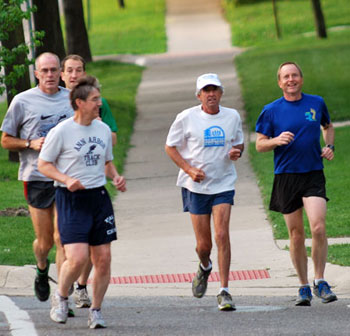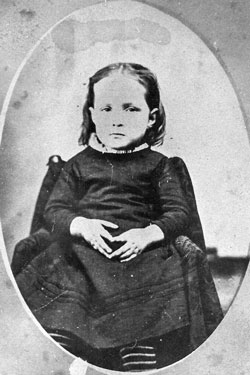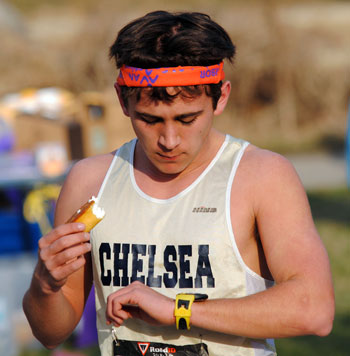Opinion Section
Photos: Shorter Routine Also Ordinary
Most Saturday mornings at 7:30 a.m., some runners who call themselves the Nasty Boys Glee Club will gather near the corner of Cambridge Road and Washtenaw Avenue in Ann Arbor. The place is the very center of Ann Arbor – as defined by the Google Maps push pin for Ann Arbor. It’s known as “the benches” in NB circles – for the sit-able amenities in Douglas Park. From there, the Nasty Boys will head off on a route and pace determined by mutual assent, but generally guided by NB member Tom Bourque.

The view is to the south along the west side of Washtenaw Avenue. Nasty Boys Glee Club runners arrive at "the benches." Left in the frame (dark shorts, gray Ann Arbor Track Club T-shirt) is Mitch Garner. To his left is his former classmate, and a special guest on the run.
Bourque has maintained running logs for decades, including all of the Nasty Boys runs, which began in late 1996. Those logs reflect that for a year or maybe two, sometime around 2006-07, I joined them on several of their weekly Saturday morning runs. There’s also a Tuesday morning edition of the Nasty Boys run, but I never ran on a Tuesday.
While the Nasty Boys are a club, their membership seems fluid and flexible – non-regular runners who appear on Saturdays as friends, colleagues, or acquaintances of current members are welcomed to run along with the group, without a lot of hazing.
That held true on this Saturday morning – June 4, 2011 – when a former classmate of Nasty Boy Mitch Garner tagged along for the run.
Garner is known among the Nasty Boys as the “Iron Bulldog” – partly because Garner is a Yale University grad, and partly because he’s known as tough and tenacious himself. On Saturday, Bourque deferred to Garner on selection of the route – given that Garner had brought a guest.
So the group of a dozen or so runners headed west through the Burns Park neighborhood on a course for the University of Michigan athletic campus, completed a ceremonial lap around the track at Ferry Field, skirted the Crisler Arena renovations, crossed the East Stadium bridge, and then dove back into Burns Park. They wound up at Garner’s house, where he was serving brunch.
A group brunch is not part of the Nasty Boys Saturday morning routine. But when the men’s marathon gold medalist at the 1972 Olympic games joins you for a run, a break from the usual routine seems warranted. And that’s who Gardner’s guest was – Frank Shorter.
Shorter is in town to participate in this year’s 38th edition of the Dexter-Ann Arbor Run, hosted by the Ann Arbor Track Club. The Sunday, June 5 event includes 5K, 10K and half-marathon distances.
Celebrating the extraordinary is easy. Celebrating the routine and the ordinary – which is most of life – is more difficult. So I was envious of the Nasty Boys on Saturday, because I was not able to run alongside a legend like Frank Shorter. But I was also envious of Frank, because I was not able to join the Nasty Boys in their routine, regular run.
I did take some photos. [Full Story]
Column: No Happy Ending at Ohio State
The Jim Tressel era at Ohio State started on Thursday, Jan. 18, 2001.
The Buckeyes happened to have a basketball game that night against Michigan, so it was a good opportunity to introduce their new football coach. When Tressel stood up to speak, he knew exactly what they wanted.
He was hired on the heels of John Cooper, whose record at Ohio State was second only to that of Woody Hayes. But in 13 seasons, Cooper’s teams lost to Michigan a stunning ten times. Can’t do that. And you can’t say, “It’s just another game,” either – which might have been his biggest mistake.
Knowing all this, Tressel told the crowd, “I can assure you that you will be proud of your young people in the classroom, in the community, and most especially in 310 days in Ann Arbor, Michigan, on the football field.”
The place went crazy. “At last,” they said, “somebody gets it!” [Full Story]
Monthly Milestone: A Different Beast
Editor’s note: The monthly milestone column, which appears on the second day of each month – the anniversary of The Ann Arbor Chronicle’s Sept. 2, 2008 launch – is an opportunity for either the publisher or the editor of The Chronicle to touch base with readers on topics related to this publication.
It’s also a time that we highlight, with gratitude, our local advertisers, and ask readers to consider subscribing voluntarily to The Chronicle to support our work.
The May meeting of the University of Michigan board of regents was remarkable for a rare display of discord. It’s the only time I can recall that this particular board has publicly voiced disagreement with the administration. It’s the only time I can remember some unscripted debate unfolding among regents on a substantive issue – the issue was a resolution recognizing the right of graduate student research assistants to unionize.

Bezonki, like The Chronicle, is a different kind of beast – he's sometimes surprised by what he reads in the newspaper. This is a preview panel from the upcoming June edition of The Chronicle's comic – a monthly nod to the time-honored tradition of the Sunday funnies. Bezonki is created by local artist Alvey Jones. (Image links to Bezonki archive.)
After the meeting, I happened to be leaving at the same time as UM president Mary Sue Coleman. As we walked down the hall together, I told her that despite the tension and clearly deep disagreement on this issue, I had found it refreshing to see an actual public debate at the meeting. It simply never happens.
Whatever disagreements exist among regents – or between regents and the administration – seem to be aired privately. When tuition rates are set, some regents will read statements of polite disagreement, before casting their votes of dissent. But most action items are approved unanimously, with little if any comment. I told Coleman that I realized the meeting had been at times uncomfortable, but that I appreciated the debate.
She gave me a withering look. “I’m sure you do,” she said, crisply.
Her pointed disdain took me aback – though I should have seen it coming. From her perspective, she’d been delivered a very public defeat on an issue she is passionate about, grounded in her personal experience. She seemed weary. But her comment also revealed a view of the media that’s more prevalent and more justified than I like to admit. It’s a view of reporters as hungering for headline-grabbing, website-traffic-sucking stories – and if the facts don’t quite deliver the juice, well, there are ways to spice up reality. There’s a reason why news gathering is sometimes called “feeding the beast.”
From that perspective, Coleman perhaps heard my remarks as the comments of someone who was hungry for more drama of regents mixing it up in front of the plebeians. Ouch.
So on my drive home from UM’s Dearborn campus – where the regents meeting was held – I thought about why the exchange had touched a nerve for me. For one, I’m dismayed that elected officials and other civic leaders are so often reluctant to hold difficult discussions in public. The board of regents is not the only body that does its business like a tightly choreographed kabuki dance. But as a journalist, I’m angered when irresponsible actions by those who earn a livelihood as part of the news media give public bodies a cheap excuse to be even more closed-off. [Full Story]
Column: A Season of Small-Stakes Softball
I went to Ann Arbor Huron High School, considered by every objective source to be the greatest high school in the history of the universe. And one of the things that made it so great when I was there was an intramural softball league.
Maybe your clearly inferior high school had one, too. But the IM softball league at Huron was created and run entirely by students – the burnouts, no less. That meant the adults, perhaps wisely, wanted nothing to do with it.
So the burnouts got the park permits – God bless ‘em – and every clique had a team, from the guys in auto shop to marching band. They gave their teams names like the Extra Burly Studs, the Master Batters and – yes – the ‘Nads. If you pause to think of their cheer, you’ll get the joke.
My buddies and I failed to get a team together our junior year, but our senior year, we found inspiration. Most of my friends weren’t playing spring sports, so we came home every day after school to catch “Leave It To Beaver” re-runs on Channel 20 – on something called UHF. (Kids, go ask Grandpa.)
Come softball season, we were moved to build a team around that very name: The Cleavers. But if we were going to face battle-tested squads like the All-Star Rogues and the Ghetto Tigers, we knew we’d need an edgier name. And that’s when we came up with – yes – the Almighty Cleavers. You know, to instill fear in our opponents.
You can imagine how well that worked. [Full Story]
Column: The Sport of The Dance
This tale of woe takes place in the ninth grade, back when ninth graders still stayed in junior high.
I had detention. I don’t remember why. But so did the prettiest girl in the class, whom I’ll call Rhonda – because that was her name.
The catch was, she was dating Benny, the captain of the football team. But, at detention, I learned there was trouble in paradise. Oh yes. They had broken up, with just four days to go before the big ninth grade dance. Tragic!
We had a fine chat when I walked her home, so when I got home, I decided, what the heck. I called her up to ask her to the dance. Sure, she said, why not.
Simple stuff! [Full Story]
In the Archives: Faint Footprints
Swastika slippers made in Ypsilanti were once openly advertised in national magazines – including Collier’s and Cosmopolitan. In its day, the footwear didn’t cause outrage, or taint the city as sympathetic to Nazis – even though two other Ypsi companies made similar items. The fringed footwear pre-dated Hitler’s rise by around 20 years.
The swastika slipper was made in the Indian Shoe Company’s little third-floor factory at 17-21 Cross Street, above the present-day Fantasy Attic costume store. In the high-ceilinged space full of light from large south-facing windows sat an array of shoemaking machines with tough leather-penetrating needles, operated by about a dozen women and a few men.
Benjamin Boyce managed the company, but soon moved on to become the bookkeeper for the Peninsular Paper mill. His lengthy December 12, 1956 Ypsilanti Daily Press obituary makes no mention of his involvement with the Indian Shoe Company. [Full Story]
Column: What Sports Teaches Us
Sometimes the real world is so overwhelming it sneaks into sports. One of those times occurred after 9/11, when the crowd at Yankee Stadium sang “God Bless America,” with all their heart. I’m not very religious, but it sounded right to me.
It seemed appropriate that that signature moment, when we needed to be together, occurred in our country’s most hallowed arena, the nation’s front porch. We are probably the most sports-soaked culture in the world – we’re the ones who pay for the Olympics, after all – and I believe our code of conduct when we’re competing often represents our values at their best.
People like to say sports teaches us how to be aggressive. But you can learn that through alley fighting. Any jerk with no regard for others can be aggressive. Prisons are filled with them – 9/11 was conceived by them.
And it’s easy to play by the rules, too, if you never defend yourself.
So, I disagree. What sports teaches us is how to be tough without crossing the line. That’s the crucial difference. That’s why every sport I know not only has official rules, but unwritten ones, too, that anyone who cares about the sport is expected to follow.
If you’ve ever coached – any sport, any age – you know that is one of the hardest lessons to teach. And, I believe, one of the most important. [Full Story]
Monthly Milestone: In Defense of Detail
Editor’s note: The monthly milestone column, which appears on the second day of each month – the anniversary of The Ann Arbor Chronicle’s launch – is an opportunity for either the publisher or the editor of The Chronicle to touch base with readers on topics related to this publication. It’s also a time that we highlight, with gratitude, our local advertisers, and ask readers to consider subscribing voluntarily to The Chronicle to support our work.
Writing on Damn Arbor, a blog maintained by a half-dozen self-described “grad students, townies, and derelicts,” Quinn Davis wondered recently: “So. If a citizen gasps during a city council meeting but no one reads about it, what’s the point?”
Davis posed the rhetorical question in the context of an article she’d written for the Washtenaw Voice, a Washtenaw Community College publication she edits. About that article, her advisor ventured: “I worry that our readership may not be that interested enough to get through 800 words you have so far.”
Here at The Ann Arbor Chronicle, we would also worry about an 800-word article. We’d wonder what happened to the other 5,000 words.
Count that exaggeration as a rhetorical flourish.
In fact, since since June of last year, we’ve routinely published items shorter than 500 words. These items are outcomes of individual public meeting votes and other civic events – they’re collected in a sidebar section we call the Civic News Ticker. Readers can view all those items in one go on the Civic News Ticker page. Readers who prefer to receive The Chronicle using an RSS feed reader can subscribe to just the Civic News Ticker items with this feed: Civic News Ticker Feed.
But back to the rhetorical question: What is the point of ever including details that most people might not ever read, in an article that tops 10,000 words? [Full Story]
Sunday Funnies: Bezonki
In The Archives: Story Makes Full Circuit
Editor’s note: In her most recent local history column written for The Chronicle, “When Work Was Walkable,” Laura Bien described a series of relationships that existed 100 years ago between people who lived within walking distance of their work. She included the following lines: “When Daniel [Quirk] visited the mill, he may have been driven by his coachman, Manchester Roper. By 1910, Manchester had been hired as one of the two servants in Daniel’s household.”
A Chronicle reader recognized that his grandmother had been the other servant. That reader contacted Bien. And Bien got permission to explore the family archives. This month’s column grew out of that research. Fair warning: There’s a bit of ground to cover first before you’ll learn the identity of that reader. But as always with Bien’s text, it’ll be worth the wait. Keep your eye on Mabel.
As 1900 began, 77-year-old York Township farmer Horace Parsons knew that his wife Maria was gravely ill.
His first wife Margaret had died half a century earlier, three years after their New Year’s Day wedding. Horace married his second wife Mary Ann on New Year’s Day, 1850. Just months later, his mother Rebecca died. The following year, Mary Ann died, possibly in childbirth, and Horace’s father Orrin died.
Horace had seen them all laid to rest in Saline’s Oakwood Cemetery.
Horace married his third wife Maria on May 14, 1860. Over their four decades together, Horace and Maria shared the hardships of 19th-century Michigan farm life. They lost one of their children. They survived lean years early in their marriage, selling off sheep, pigs, and farm machinery. Unlike some neighbors, they hung on to their mortgage, expanding the farm from 30 acres to 50 in 1870 and 66 a decade later.
That year Horace’s restored flock of sheep was up to nearly 80 head and 30 lambs, plus cows and pigs. He grew oats, beans, wheat, potatoes, and Indian corn, and tended 2 acres of apple trees. His and Maria’s place was the typical mixed-crop, mixed-livestock Washtenaw County farm of the era. The heterogeneity of their farm and those of their neighbors was insurance against the not uncommon disasters that regularly struck down one or another animal or crop.
Now his and Maria’s time together, he could see, was ending.
Horace hired a local girl to help. Mabel was a teenager, though neither the term nor the concept existed when she came on as a servant on Horace’s farm. Mabel was the oldest child of brickyard worker and general laborer Orson Pepper and his wife, homemaker Myrtie. The young mother had been a schoolgirl only shortly before Mabel’s birth in 1884. [Full Story]
Column: Ann Arbor Parking – Share THIS!
It’s budget season for the city of Ann Arbor.
Over the last half decade, Ann Arbor’s annual spring budget conversation has evolved to include a discussion of public parking system revenues.

In discussions about parking revenue, it’s been suggested that what the city of Ann Arbor is proposing is the equivalent of a tax on downtown parkers. (Photo illustration by The Chronicle. This is not what Ann Arbor parking meters actually look like. Yet.)
This year is no exception. The city council’s public hearing on the budget takes place at its May 2 meeting, with a vote on the 2012 fiscal year’s budget scheduled for May 16. At that May 2 meeting you’ll also hear the city council discuss revenues from the public parking system. The board of the Ann Arbor Downtown Development Authority – which manages the city’s public parking system – will meet at noon the same day to ratify its side of a contract renewal.
As likely as any other scenario is an offer from the DDA for the city to receive 17% of gross revenues from the public parking system for each year of an 11-year term. But that offer stands a decent chance of getting rejected by the city council. The city’s last bargaining position was 18% for a 10-year term and multiple three-year renewals.
Public parking revenues were already part of council deliberations at a city council budget work session on April 11, when city administrator Roger Fraser had given a dress rehearsal of his budget proposal. At the work session, councilmembers and Fraser played out a scene, in which councilmembers offered up questions to Fraser to elicit this conclusion: If the city does not extract enough revenue from the city’s public parking system, the city will need to lay off additional police or firefighters – four this year and two the following year.
The scene was reprised on April 19, when the city’s budget was formally premiered. The budget did not appear to depart in significant ways from the department-by-department budget impacts that city managers have presented to the council at a series of work sessions since the beginning of the year.
On April 19, it was the city’s CFO Tom Crawford (later in the meeting to be appointed interim city administrator) who played the role of the “numbers guy.” So it was Crawford who gave the recommendation in response to councilmember prompts: Without sufficient revenue from the public parking system, he would recommend laying off an additional four public safety officers. That’s in addition to the five police officers, three other non-officer positions in the police department, and five firefighters who are already slated for layoff.
Councilmembers Christopher Taylor, Carsten Hohnke, Marcia Higgins, Stephen Kunselman and mayor John Hieftje played starring roles in their portrayal of elected officials that evening. But more to the point of this column, I wonder who the city council’s imagined audience is for this sort of theater? Presumably it’s for an audience that pays the price of admission. But in Ann Arbor, it’s an audience that typically doesn’t pay much attention: the city’s shareholders.
Yes, that’s exactly the word I want. Shareholders. [Full Story]
Column: Remembering Jim Mandich
On Tuesday, the Michigan football family lost another beloved son, Jim Mandich, who died of cancer at age 62.
Regular readers of this space know I’ve had to write a few elegies already this year, and I’m not sure if we can bear another one right now.
I’m not sure Mandich would want any more, either, beyond his funeral. As he told Angelique Chengelis of The Detroit News last fall, after he was diagnosed with cancer, “I said to myself, ‘No whining, no complaining, no bitching. You’ve lived a damned good life. You’ve got a lot to be thankful for.’”
And he did, including a great NFL career and three grown sons – good guys, good friends. But I’m sure he’d like to be remembered – don’t we all? – and I thought you might enjoy a story or two about an unusually talented and charismatic man. [Full Story]
Column: Michigan Hockey’s Cinderella
Last year, Michigan’s men’s hockey team was in danger of breaking its record 19-straight appearances in the NCAA tournament – a streak that started before many of the current players were even born. They were picked to finish first in the league – but they finished a disastrous seventh, unheard of in Ann Arbor.
The only way they could keep their streak alive was to win six league playoff games to get an automatic bid. Oh, and they’d have to do it with a back-up goalie named Shawn Hunwick, a 5-foot-6 walk-on who had never started a college game. Things looked bleak, to say the least.
But the kid caught fire. The Wolverines actually won all six games, they stretched their streak to 20 straight NCAA tournaments, and Hunwick won the league tournament MVP award. He was like Rudy – with talent.
But there are no sequels for Cinderella. One run is all you get. [Full Story]
Balancing Ann Arbor, Detroit – and a Vision
[Editor's Note: HD, a.k.a. Dave Askins, editor of The Ann Arbor Chronicle, is also publisher of an online series of interviews on a teeter totter. Introductions to new Teeter Talks, like this one, also appear on The Chronicle's website.]

Dante Chinni, co-athor of "Our Patchwork Nation." That's a Tigers cap he's wearing, and it's not accidental.
“I don’t want to be another city. I resent the fact that we are compared to other cities when projects are being proposed.”
That was Ali Ramlawi, owner of the Jerusalem Garden on South Fifth Avenue in downtown Ann Arbor, addressing the April 4, 2011 meeting of the Ann Arbor city council. He was criticizing the Ann Arbor Downtown Development Authority, and advocating against a proposed conference center and hotel project on the Library Lot – the council voted the project down later that evening.
“Ann Arbor will change … but it won’t become Detroit.”
That was Dante Chinni, while riding the the teeter totter on my front porch last Thursday afternoon. Chinni has made it part of his job to compare communities like Ann Arbor – Washtenaw County, actually – to other places in the country.
Who is Dante Chinni? And why should Ann Arbor care what he thinks?
On his website, Chinni describes himself as a “a card-carrying member of the East Coast Media Industrial Complex.” The part of his job that lets him compare one place to another – in a statistically sophisticated way – is a project Chinni conceived called Patchwork Nation. It’s funded by the Knight Foundation. The effort has already produced a book, which he co-authored with James Gimpel: “Our Patchwork Nation: The Surprising Truth about the ‘Real’ America.”
Washtenaw County is featured in the chapter that introduces readers to the concept of a “Campus and Careers” community type. The classification, as well as a read through Dante’s Talk, confirm that mostly what defines Ann Arbor – at least for people on the outside looking in – is its place as the home of the University of Michigan. And certainly for people on the inside, it’s difficult to argue that UM isn’t currently the single most important institution in the community.
But some insiders – and by this I mean not just people who live, work and play here, but actual Ann Arbor insiders – are starting to float the question of what else Ann Arbor might aspire to be besides home to “the most profound educational institution in the Midwest.” [Full Story]
Column: A Life Lived Fully
If you’re not a Michigan football fan, you probably haven’t heard of Vada Murray, but you might have seen his picture. It’s one of those iconic images of Michigan football, along with Tom Harmon standing in his mud-soaked, torn-apart jersey, and Desmond Howard diving to catch a touchdown pass against Notre Dame.
But the photo I’m talking about shows Vada Murray and Tripp Welborne soaring skyward to block a field goal. They were a kicker’s nightmare. But even when they got a hand on the ball, it simply denied their opponent three points. That’s not the kind of thing that wins you a Heisman Trophy or an NFL contract. They don’t even keep records of those things.
But more than two decades later, something about that photo still resonates. Maybe it’s because it captures their effort, their intensity, their passion – all of it spent just to give their teammates a slightly better chance for success. There is something noble in that. And we recognize it – which is why they’ve been selling that photo at the frame store on Ann Arbor’s Main Street for years, right along side the legendary poses of Harmon and Howard. [Full Story]
Column: DDA – The Sure Thing
In 1985, Rob Reiner made a movie called The Sure Thing, starring John Cusack as a college student who made a 3,000-mile journey on a break from school in order to meet up with a “sure thing” – a girl who didn’t need any convincing to have sex.
Given the movie’s plot, it was a little odd to hear a scene from it cited by an Ann Arbor city councilmember to bolster a budget argument.
Carsten Hohnke, who represents Ward 5 on Ann Arbor’s city council, used the “credit card scene” from that movie – without naming the movie or giving the broader context of the plot – during a meeting of two committees on Monday morning, April 4, 2011. Known as the “mutually beneficial” committees, one is composed of Ann Arbor Downtown Development Authority board members and the other is made up of city councilmembers.
To understand the reference to The Sure Thing scene, it’s useful to have some brief background on the city-DDA parking drama. Understanding that drama, in turn, leads to some interesting conclusions about the relationship between the city and the DDA, and about what city councilmembers might be willing to say to get what they want. [Full Story]
Monthly Milestone: Internet Twinkies
Editor’s note: The monthly milestone column, which appears on the second day of each month – the anniversary of The Ann Arbor Chronicle’s launch – is an opportunity for either the publisher or the editor of The Chronicle to touch base with readers on topics related to this publication.
It’s also a time that we highlight, with gratitude, our local advertisers, and ask readers to consider subscribing voluntarily to The Chronicle to support our work.
I’d like to begin this month’s milestone column by sharing some good news about one of The Chronicle’s writers – Jennifer Coffman, who covers the Ann Arbor Public Schools board of education for us. Last week she gave birth to a baby girl: Eleanor Olivia Coffman. So she’s on a break from The Chronicle for a while.
Until Coffman returns, Eric Anderson will be providing The Chronicle’s AAPS board coverage. Eric grew up in Ann Arbor and is a graduate of Hope College. His experience includes work as a reporter at the Hillsdale Daily News and an editorial intern at the Washington Post Express. He’s planning to attend graduate school later this year.
Coverage of the AAPS board has become part of the meat-and-potatoes reporting provided by The Chronicle, along with reports on the Ann Arbor city council, the Washtenaw County board of commissioners and many other public bodies.
But not everything published in The Chronicle is meat and potatoes. I think it’s a relatively small portion of our overall corpus, but some of our material is probably more like a Twinkie than a piece of meat.
Many of the Stopped.Watched. items, for example, might be analyzed as more like Twinkies than a T-bone steak. Which, I think, is fine – for Twinkies, like T-bones, are also food. I wouldn’t want to make a meal out of Twinkies, though.
The Ann Arbor Active Against ALS Twinkie Run, which took place on April 1, serves as a nice analogy to the way we think of The Chronicle material that’s more like Twinkies.
On Friday evening in Gallup Park, the 271 runners who competed in the 5K race were presented with a choice on each of two laps through the park: (1) Take the time to eat a Twinkie and earn a 1-minute deduction to their finish time, or (2) Just keep running and take the straight-up meat-and-potatoes time. The annual run was observed last year as a Stopped.Watched. item. [Full Story]
Column: Arbor Vinous
For over 40 years, Ann Arbor wine retailer Village Corner was a fixture on South University, near the University of Michigan’s Central Campus, until it closed last November to make way for a student high-rise at 601 S. Forest.
Dick Scheer, an iconic figure in Michigan wine circles, owned the store that entire time. When it closed, Scheer stashed his inventory in temporary quarters, took his Terminator turn – “I’ll be back!” – and pledged to reopen shortly in a venue with better parking, as he told Sandra Silfven of the Detroit News.
Then, nothing. Scheer went to ground, keeping his own counsel as he sought a new location, to the not-infrequent exasperation of long-time customers and members of the media alike.
Until last week, when the website of Michigan’s Liquor Control Commission (LCC) spilled the beans: on March 17, Village Corner applied to relocate its beverage licenses to another campus-adjacent address.
North Campus, that is.
The new location, at 1747 Plymouth Road in The Courtyard Shops, sits between No Thai! restaurant and Jet’s Pizza, in a storefront formerly occupied by Tanfastic tanning salon. [Full Story]
Column: Lawsuit Aftermath – 6 Months Clean
At a Jan. 18, 2011 hearing, the 22nd Circuit Court judge Melinda Morris entertained two motions by the city of Ann Arbor in response to a lawsuit filed by The Ann Arbor Chronicle.
The lawsuit alleged that during a July 19, 2010 session held by the city council, the council had violated the Michigan Open Meetings Act – by voting to enter into a closed session to discuss written attorney-client privileged communication, but instead straying from that narrow purpose to reach a public policy decision about medical marijuana businesses.
It’s uncontroversial that the council did make a decision in an open session on Aug. 5, 2010 to develop an ordinance that would ensconce medical marijuana businesses in local zoning regulations, by first establishing a moratorium on establishing additional medical marijuana businesses. What The Chronicle essentially alleged was that the Aug. 5 decision to develop local legislation on medical marijuana businesses had already been determined at the July 19 closed session.
The first motion by the city of Ann Arbor was rejected by Judge Morris. The city had asked her to find that The Chronicle’s suit was frivolous, not managing even to state a claim, and further asked that sanctions and fines be imposed.
However, on the city’s second motion – which asked Morris to find that there was insufficient evidence of an OMA violation to warrant subjecting councilmembers and the city attorney to depositions, and that she should dismiss the claim – Morris ruled in favor of the city of Ann Arbor.
In reaching the conclusion that additional discovery of facts should not be allowed, Morris appeared to give significant weight to councilmember depositions affidavits, which they all signed, asserting that they had voted to go into the closed session on July 19, 2010 in part to discuss a May 28, 2010 legal advice memo written by the city attorney, Stephen Postema. All the affidavits further asserted that the council had not made any decision during the July 19 closed session. Morris also appeared to give significant weight to the idea that even if an OMA violation occurred on July 19, then it would have been “cured” by the council’s deliberations and decision made during their open session at the Aug. 5, 2010 meeting.
In this report, we will review some points of legal interpretation on which we disagree with Judge Morris, including the significance of a surprising omission in the affidavits signed by the city attorney and the mayor.
But we begin with the observation that since being served The Chronicle’s lawsuit six months ago – about a closed session conducted on the claimed basis of attorney-client privilege – the city council has not held a single closed session of that kind. That’s easily the longest closed-session-free span the council has achieved for attorney-client privileged-based sessions in more than two years.
That seems to reflect an implicit acknowledgment by the city attorney and the council that they’d been holding more of these kinds of closed sessions than were actually warranted. We gave serious consideration to filing an appeal in this case. The council’s apparent change in behavior has convinced us that our decision not to allocate additional financial resources to an appeal was the right one. Part of our goal was to rectify a specific pattern of inappropriate behavior on the council’s part, and we appear to have achieved that.
Compared to the possibility of establishing new case law on a specific point, we think a more general approach to reform of the Michigan Open Meetings Act and the Freedom of Information Act, through legislative efforts, is likely to yield stronger and longer-lasting improvements in these open government laws. [Full Story]
Column: Honoring Jean Ledwith King
Most of the time, I don’t think about gender equity. Along with millions of other American women my age and younger, I’ve benefited from those who spent their lives enduring countless humiliations and setbacks, to achieve for their daughters and nieces and friends what I now enjoy – the luxury of not thinking much about gender equity.

Jean Ledwith King at the March 26, 2011 dinner to rename the Women's Center of Southeastern Michigan in her honor. (Photo courtesy of Wayne Dabney)
On Saturday, about 300 people gathered to pay tribute to one of those women whose work broke ground for the rest of us: Jean Ledwith King. The event was hosted by the Women’s Center of Southeastern Michigan, which has been renamed in her honor.
As a former board member for the center, I expected to see some familiar faces – staff, volunteers and donors I’d known from my relatively short tenure there. But the turnout for Jean went far beyond that. Judges and attorneys, university administrators, elected officials from across the county and state, business leaders and many others came to say thanks for her years of dogged work on behalf of equal opportunity for women. She calls herself a bomb thrower, but on Saturday she was recognized more for the foundation she’s helped build, particularly through her work on Title IX issues related to high school and college athletics.
Jean’s life story is inspiring, as were reflections by the event’s keynote speaker, Olympian Micki King. (Though they aren’t related by blood, they certainly are in spirit.) Their stories made me think of other histories, too – we all have them, closer to home and less notable, perhaps, but also worth honoring as a reminder of how it’s possible to make dramatic societal changes within a lifetime. [Full Story]
Column: Library Lot – Bottom to Top
Editor’s note: Although the parcel immediately north of the Ann Arbor District Library’s downtown location is known as the Library Lot, it does not belong to the library, but rather to the city of Ann Arbor.
Last Thursday, news of a breach in the earth-retention system of a downtown Ann Arbor construction site had reached all the way to Detroit’s Channel 4 News. Channel 4 sent a crew Friday evening to file a report. It was tagged on the Channel 4 website with the summary: “An Ann Arbor construction project is sinking, literally.” Chalk that up to the hyperbole of television news.

Top: View to the northeast along Fifth Avenue from Valiant Partners' concept for a conference center and hotel, proposed for the top of the Library Lot underground parking garage. Bottom: Breach in the earth retention system for the underground parking garage currently under construction on the Library Lot.
While the roughly 640-space underground parking garage, being built by Ann Arbor’s Downtown Development Authority, is not sinking in any way, a conference center and hotel proposal for the top of the underground structure might be sinking.
At first glance, the 190,000-square-foot project proposed by Valiant Partners Inc. seems like it’s on a path to approval by the city council. In November 2010, an advisory committee – charged with evaluating responses to a city of Ann Arbor request for proposals issued in late 2009 – finally settled on the Valiant proposal as the best of the six the city had received.
That decision came with the aid of Roxbury Group, a consultant hired to help evaluate the proposals and to negotiate an agreement with a developer. At an early March meeting of the advisory committee, a Roxbury representative presented a draft letter of intent, which had been worked out by Valiant and Roxbury, to be signed by the city of Ann Arbor and Valiant. The committee voted unanimously to recommend that the city council consider the letter of intent.
Then, on March 14, the city council held a work session on the proposed conference center. The council heard essentially the same presentation about the letter of intent that Roxbury had made to the advisory committee. The council is scheduled to consider the letter formally at its second meeting in April, which is now scheduled for Tuesday, April 19, to accommodate the first night of Passover. The letter of intent calls for a development agreement to be presented to the city council within four months of signing the letter of intent – which would mean sometime near the end of August 2011.
But I think it’s clear at this point that a development agreement between Valiant and the city of Ann Arbor to develop the Library Lot would not achieve the necessary eight-vote majority for an actual real estate deal. That’s why I think the city council might vote down the letter of intent – even if there are at least six councilmembers who would support going forward with the letter, which is all it would take for the letter’s approval.
I base that conclusion on remarks made by councilmembers at the March 14 work session, and regular politics as reflected in the council’s history – both recent and ancient. But before considering politics, let’s dig into some really ancient history – the kind measured in geological time – to gain some additional insight into why a pile of dirt spilled unintentionally into the underground parking garage construction pit. [Full Story]
Column: The Fab Five’s Real Leaders
The past two Sundays, ESPN has been running a documentary called “The Fab Five,” about Michigan’s famed five freshman basketball players who captured the public’s imagination twenty years ago. It’s not quite journalism – four of the Fab Five produced it themselves – but it is a pretty honest account of what those two years were all about. And it is undeniably compelling. The first showing reached over two million homes, making it the highest rated documentary in ESPN’s history.
A lot of this story, you already know: In 1991, five super-talented freshmen came to Michigan, and by mid-season the Wolverines were the first team in NCAA history to start five freshmen. They got to the final game of March Madness before losing to the defending national champion Duke Blue Devils. The next year, they made it to the finals again, but this time they lost to North Carolina when Michigan’s best player, Chris Webber, called a time-out they didn’t have.
Along the way they made baggy shorts and black socks fashionable, and imported rap music and trash talk from the inner-city playgrounds to the college courts. It’s been that way ever since. [Full Story]
Column: The Tragedy in Fennville
Fennville, Michigan – On Monday, I drove across Michigan to see a Class C regional semi-final basketball game, pitting tiny Schoolcraft High School against even tinier Fennville.
Both schools were undefeated – but that’s not why I was going. I was going to see the impact of a young man who would not be there.
Before I drove back, I also learned how quickly even a record-breaking basketball game can become utterly insignificant – and then, just a few days later, how the next game can matter so much.
Fennville is about 200 miles from Detroit, but it might as well be 200 light years. When you approach Fennville, you pass a sign declaring, “Hometown of Richard ‘Richie’ Jordan, Member of the 2001 National High School Sports Hall of Fame.”
You haven’t heard of Richie Jordan, who graduated almost 50 years ago and stands only 5-7. But everyone around here has, and down at the Blue Goose Café, they still talk about all the records he set in football, basketball and baseball. But the last few years, they’ve been talking about Wes Leonard. [Full Story]
Column: History Repeats at AnnArbor.com
When we first heard about the layoffs at AnnArbor.com last Thursday – starting with cryptic comments on Facebook, quickly spreading through the Ann Arbor News diaspora and then the broader community – I had a sickening sense of déjà vu. It was two years ago this month that the out-of-state owners of our town’s daily newspaper announced their plans to close the business, tearing apart the lives of its workers, fraying some of the Ann Arbor community’s fabric, and drawing national attention for the decision’s fearlessness or folly, depending on your view.
I wrote about their decision at the time from a personal perspective. Even though I had left the News the previous year to co-found The Chronicle, it was still a place that employed many friends and colleagues I respected. Watching that organization get dismantled was emotional, for many reasons.
Although we began to hear about the layoffs on Thursday last week, we decided not to write immediately about that news. In part, we reasoned that it should be AnnArbor.com’s story to tell first, and I held out hope that executives at AnnArbor.com would be straightforward in letting the community know about their decision, and the rationale behind it.
I also hoped they would wrap into their coverage the news that three other key staff members – news director Amalie Nash, higher education reporter David Jesse and point person for reader interaction Stefanie Murray – had all been hired by the Detroit Free Press. All three left at the end of February. All had previously worked for many years at The Ann Arbor News, and had been initial hires at AnnArbor.com.
Considered separately, either the set of layoffs or the three departures would have had a significant impact on the organization. But with both events taking place within two weeks, it counts as the most dramatic personnel change since AnnArbor.com’s launch. [Full Story]
Column on Hoops: Basketball, Civics
On Tuesday, a capacity crowd packed a local Ann Arbor venue to watch a five-person team do its work. Part of the color commentary included talk of game-changing players, and speculation about who had the best center of all the conferences. Everyone knew that whichever team prevailed on Tuesday would not win the whole tournament – it would just advance to the next round.

The basketball hoop on the south end of the court in Ann Arbor's newly renovated West Park. (Photo by the writer.)
Here’s a highlight reel of how events unfolded on Tuesday. Play opened with a disputed call, and one of the fans nearly got tossed out of the venue. There was a guy with a red sweater, reminiscent of those favored by Bob Knight when he coached the Indiana University squad, even though he was not the guy in danger of getting tossed. He was actually prepared to do the tossing.
Early on, the coach told the team about the “four corners” – which some older sports fans might recognize as a stalling style of basketball made popular by legendary University of North Carolina coach Dean Smith. And the team managed to hold the ball for one final shot, which it made. The cheerleaders cheered. The victors were valiant … hail, hail, etcetera.
The venue? It was the fourth floor meeting room of city hall. And the five-person team was the committee charged with evaluating proposals for use of the city-owned Library Lot. That’s the parcel atop the Fifth Avenue parking structure currently under construction.
Who says local civic affairs isn’t at least as interesting as NCAA basketball? Well, actually, most readers would say that, I’m guessing.
But here’s something I think we can all agree on: Fans at basketball games get to cheer or boo as loud as they like … within certain parameters. The parallel principle for public meetings, like the one on Tuesday, is that members of the public should be allowed to address the group during its meeting.
The city of Ann Arbor’s stated written policy on this is actually quite clear: Even entities that are not public bodies under the Open Meetings Act should, to the best of their abilities, conform with the spirit of the OMA – which includes a provision for public participation at meetings. [Full Story]
Column: OSU Treads Too Lightly on Tressel
On Tuesday night, Ohio State athletic director Gene Smith flew back from New York, where he had been running the NCAA basketball selection committee, to conduct a press conference. He announced he was suspending his head football coach, Jim Tressel, for the first two games of the 2011 season.
It looks like Tressel has gotten himself into a bit of hot water. That’s why Smith, his boss, flew back to make sure everybody said they were “taking responsibility” – a phrase which changed some time in the last decade, and now means the exact opposite.
It was fine theater. [Full Story]
Column: Happiness in Motion
I attended an open house at The Health & Fitness Center at Washtenaw Community College not because I wanted to work out, but because I’d heard it was the most fantastic rec center in the entire world.
I learned two things that day: It really is the most fantastic rec center in the world. And working out can indeed be that joyful, endorphin-releasing high I’ve heard about but rarely experienced.
I felt strong. I felt pampered. I wanted to sell my house and move closer to WCC so I could work out every morning and live happily ever after.
At the very least, I hoped a bit of that excitement would carry over long enough to pump up the at-home workouts. Didn’t happen. Not even a little. I have an elliptical machine in my office next to a window facing a TV. I have no excuse other than this: I don’t wanna.
Can anyone else relate? It’s two months into the new year. How’s that work-out resolution working out? [Full Story]
Column: Don’t Look Down on Boykins
In the late ’90s, Eastern Michigan University assembled some its best basketball teams. The Eagles were so good they stunned the Duke Blue Devils in the first round of the 1996 NCAA tournament, 75-60. They were led by the nation’s second-leading scorer in 1998 – a guy named Earl Boykins – who the program said stood just 5-foot-8-inches tall. This, I had to see.
I watched Boykins torch Western, Central and Ball State. He could handle the ball, shoot it and pass it better than anyone on the court – even though he was shorter than everyone on the court. Yep, this was a story.
When I interviewed him, the story just got better. He told me he was so small growing up that he learned to dribble by using a tennis ball. When he was three, his dad could sneak him into games by stuffing him in a gym bag – but, Boykins told me, “Man, that’s back when I was small.”
Then he stood up, and I quickly realized the program listing was very generous. 5-foot-8? I’m 5-foot-8 – and I towered over him. I said, “Duuuuuude! You ain’t 5-8!” [Full Story]
Monthly Milestone: Institutional Memory
Editor’s note: The monthly milestone column, which appears on the second day of each month – the anniversary of The Ann Arbor Chronicle’s launch – is an opportunity for either the publisher or the editor of The Chronicle to touch base with readers on topics related to this publication.
It’s also a time that we highlight, with gratitude, our local advertisers, and ask readers to consider subscribing voluntarily to The Chronicle to support our work.
We no longer number the monthly milestones here at The Chronicle. If we did, this one for March 2011 would be number 30. Parents with young children can probably peg 30 months to 2.5 years without even doing the math. Two and a half years does not seem like a terribly long time for a publication to stay in business – especially compared to the nearly 175-year run of The Ann Arbor News. The announcement of that paper’s closure came two years ago – on March 23, 2009. Coming as it did late in the month, the grim news did not figure in The Chronicle’s March 2009 monthly milestone.
Instead, publisher Mary Morgan filled the column that month with mostly lighter fare, including a mention about the addition of the Skyclock widget to the right sidebar of this website – scroll down to the bottom under the advertisements. Now, exactly two years later, Skyclock has again earned a spot in the milestone column – which this month is a quick tour of twilight, marijuana, and snow. [Full Story]














